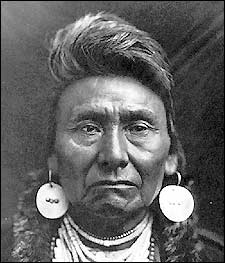Chief Joseph
(Hin-mah-too-yah-lat-kekt)
"Thunder Rolling Down the Mountain"
By Chelsie McCullough

All throughout history there have been countless wars, battles, treaties and loss. But as the United States struggled to feed the hunger for land during the 1800's, others suffered, more distinctively, Indians suffered. We look back in time and see the reign of Adolf Hitler, the dictator who plunged to world into a deep holocaust with thousands of Jews, Gypsies, and many others being sentenced to starve, freeze, and die. Even though America was said to be the Land of the Free, we've had our own holocaust. A holocaust that pushed Native American off their land, took their food, trust, lives and separated them from their families.
Hin-mah-too-yah-lat-kekt or better known as Chief Joseph was born in the Wallowa Valley in 1840 (what is now northeastern Oregon). His father Joseph the Elder was one of the first Nez Perce to convert to Christianity. Joseph the Elder took the Christian name Joseph in 1838 when he was baptized. In 1863, because of a gold rush the federal government took back six-million acres that belonged to Native Americans. Enraged, Joseph the Elder denounced the United States, destroyed his American flag and bible, and refused to be pushed off of his land onto a reservation.
Chief Joseph, was elected in 1871 to succeed his father. Chief Joseph resisted nearly all efforts to be forced onto a small reservation in Idaho. In 1877 General Oliver Otis Howard threatened a cavalry attack to force Joseph's band and other holdouts onto the reservation. Chief Joseph believed military resistance futile so reluctantly, he led his people to Idaho. Along the way, many of Chief Joseph's warriors staged raids on settlers causing the United States Army to pursued.
A band of fewer than 200 warriors defeated American troops at every turn of their journey. They did this while looking after 500 women and children throughout 1,400 miles of the Bear Paw Mountains. Although the Nez Perce came within forty miles of the Canadian border, they were brutally stopped by a force of nearly 500 American troops led by Colonel Nelson A. Miles. The tribe held out for five days in a snowstorm. The only reason they surrendered was because they had no food or blankets, they would have frozen and starved to death if they hadn't.
In the amazing attempt to get to Sitting Bulls camp in Canada, Chief Joseph had to surrender to General Oliver Howard on October 5, 1877. This brought his four month long retreat from Wallowa Valley to an end. While surrendering, Chief Joseph held his rifle out to General Howard and said:
"I am tired of fighting. I want to have time to look for my children and see how many of them I can find. Maybe I shall find them among the dead. Hear me my chiefs! I am tired. My heart is sick and sad. From where the sun stands, I will fight no more forever"
8th American History
2005 Project